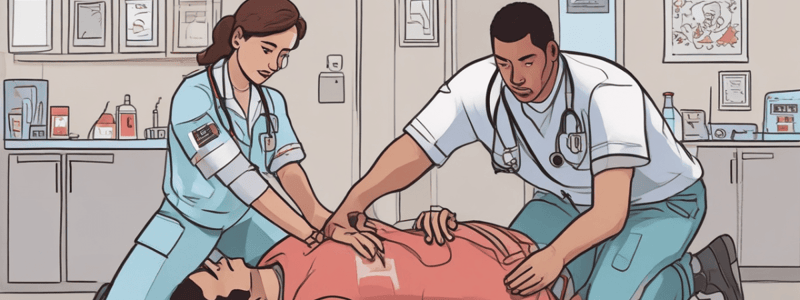Podcast
Questions and Answers
What is the duration of time to check for a pulse?
What is the duration of time to check for a pulse?
- 15 seconds
- 10 seconds (correct)
- 5 seconds
- 20 seconds
What is the medication administered after 2 minutes of CPR?
What is the medication administered after 2 minutes of CPR?
- Atropine 1 mg IV/IO push
- Amiodarone 300 mg IV/IO push
- Lidocaine 1.5 mg/kg IV/IO push
- Epinephrine 1 mg IV/IO push (correct)
What is the recommended interval for repeating Epinephrine administration?
What is the recommended interval for repeating Epinephrine administration?
- Every 2 minutes
- Every 10 to 15 minutes
- Every 3 to 5 minutes (correct)
- Every 5 to 10 minutes
What is the alternative medication to Amiodarone?
What is the alternative medication to Amiodarone?
What is the primary therapy for Cardiac Arrest victims?
What is the primary therapy for Cardiac Arrest victims?
What is the recommended method of administration for Amiodarone?
What is the recommended method of administration for Amiodarone?
What may indicate ROSC according to the protocol?
What may indicate ROSC according to the protocol?
When should the Waveform End Tidal CO2 be used according to the protocol?
When should the Waveform End Tidal CO2 be used according to the protocol?
What is the recommended dose of fluid to be used with ET administration of drugs?
What is the recommended dose of fluid to be used with ET administration of drugs?
What should happen to the body after TERMINATION OF RESUSCITATION INSIDE AN AMBULANCE?
What should happen to the body after TERMINATION OF RESUSCITATION INSIDE AN AMBULANCE?
What is the preferred management of the traumatic arrest patient?
What is the preferred management of the traumatic arrest patient?
Why is traumatic arrest approached separately from primary cardiac arrest?
Why is traumatic arrest approached separately from primary cardiac arrest?
What may exist in the post-traumatic circulatory arrest patient?
What may exist in the post-traumatic circulatory arrest patient?
What is the current stance on the use of ACLS/PALS-type medications in traumatic arrest?
What is the current stance on the use of ACLS/PALS-type medications in traumatic arrest?
What is contraindicated in the traumatic arrest patient?
What is contraindicated in the traumatic arrest patient?
What should be considered in a situation where the mechanism of injury appears inconsistent with the patient’s condition?
What should be considered in a situation where the mechanism of injury appears inconsistent with the patient’s condition?
What is the minimum pulse rate required for a patient to meet the inclusion criteria for narrow complex tachycardia?
What is the minimum pulse rate required for a patient to meet the inclusion criteria for narrow complex tachycardia?
What is the duration of the QRS complex in narrow complex tachycardia?
What is the duration of the QRS complex in narrow complex tachycardia?
What is the next step in the post-termination body movement protocol if the cause of death is unclear?
What is the next step in the post-termination body movement protocol if the cause of death is unclear?
What is the minimum age requirement for a patient to be considered for the narrow complex tachycardia protocol?
What is the minimum age requirement for a patient to be considered for the narrow complex tachycardia protocol?
What should be considered in the post-termination body movement protocol if the cause of death is likely homicide or child abuse?
What should be considered in the post-termination body movement protocol if the cause of death is likely homicide or child abuse?
Study Notes
Ventricular Fibrillation/Tachycardia Adult w/o Pulse
- Patient's age is 16 years and older
- Patient is unresponsive
- Patient is without a pulse (checked for a maximum of 10 seconds)
AED Findings
- Ventricular fibrillation or ventricular tachycardia without a pulse
Protocol
- Continue CPR and care per SB204
- Defibrillate immediately at 360 Joules (biphasic equivalent or manufacturer's recommendation)
- Immediately resume CPR
- Perform CPR for 2 minutes before another pulse or rhythm check
- Search for possible causes as listed in SB204
- Administer Epinephrine 1 mg (10 ml of 0.1 mg/mL) IV/IO push
- Repeat every 3 to 5 minutes as long as arrest continues
- Administer Amiodarone 300 mg IV/IO push
- Repeat Amiodarone 150 mg IV/IO push in 3-5 minutes if still in VF/VTach
- Lidocaine may be substituted as: Lidocaine 1.5 mg/kg IV/IO push
- Repeat Lidocaine 0.5 to 0.75 mg/kg IV/IO in 3-5 minutes if still in VF/VTach
Notes
- High-quality CPR (SB204) is the mainstay of therapy for cardiac arrest victims
- If a pulseless patient is found to have agonal or gasping-type respirations, apply AED or quick-look paddles immediately
- Consider H's and T's (see SB204)
Traumatic Cardiac Arrest (Adult & Pediatric)
- Traumatic arrest from both blunt and penetrating trauma carries high rates of mortality
- The preferred management of the traumatic arrest patient is surgical intervention at an appropriate verified trauma center
- The protocol aims to delineate patients who would benefit best from resuscitative efforts
- Do not use ACLS/PALS-type medications including epinephrine/atropine in the setting of traumatic arrest
Narrow Complex Tachycardia w/Pulse (Unstable)
- Patient's age is 16 years and older
- No history of trauma or fever
- Pulse rate greater than 150
- Patient has signs of inadequate perfusion
Protocol
- Assure airway patency and administer oxygen to correct hypoxia
Studying That Suits You
Use AI to generate personalized quizzes and flashcards to suit your learning preferences.




